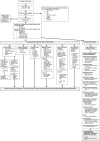Management and investigation of neonatal encephalopathy: 2017 update
- PMID: 28389438
- PMCID: PMC5537522
- DOI: 10.1136/archdischild-2015-309639
Management and investigation of neonatal encephalopathy: 2017 update
Abstract
This review discusses an approach to determining the cause of neonatal encephalopathy, as well as current evidence on resuscitation and subsequent management of hypoxic-ischaemic encephalopathy (HIE). Encephalopathy in neonates can be due to varied aetiologies in addition to hypoxic-ischaemia. A combination of careful history, examination and the judicious use of investigations can help determine the cause. Over the last 7 years, infants with moderate to severe HIE have benefited from the introduction of routine therapeutic hypothermia; the number needed to treat for an additional beneficial outcome is 7 (95% CI 5 to 10). More recent research has focused on optimal resuscitation practices for babies with cardiorespiratory depression, such as delayed cord clamping after establishment of ventilation and resuscitation in air. Around a quarter of infants with asystole at 10 min after birth who are subsequently cooled have normal outcomes, suggesting that individualised decision making on stopping resuscitation is needed, based on access to intensive treatment unit and early cooling. The full benefit of cooling appears to have been exploited in our current treatment protocols of 72 hours at 33.5°C; deeper and longer cooling showed adverse outcome. The challenge over the next 5-10 years will be to assess which adjunct therapies are safe and optimise hypothermic brain protection in phase I and phase II trials. Optimal care may require tailoring treatments according to gender, genetic risk, injury severity and inflammatory status.
Keywords: hypoxic ischaemic encephalopathy; neonatal encephalopathy; neuroprotection; resuscitation of the newborn.
Published by the BMJ Publishing Group Limited. For permission to use (where not already granted under a licence) please go to http://www.bmj.com/company/products-services/rights-and-licensing/.
Conflict of interest statement
Competing interests: NJR has received a research grant from Chiesi Pharmaceuticals and from Air Liquid for preclinical work on melatonin and argon, respectively.
Figures


References
-
- Enns G, Packman S. Diagnosing inborn errors of metabolism in the newborn: clinical features. NeoReviews 2001;2:e183–91. 10.1542/neo.2-8-e183 - DOI
-
- Hart AR, Sharma R, Rittey CD, et al. Neonatal hypertonia – a diagnostic challenge. Dev Med Child Neurol. 2015;57:600–10. - PubMed
-
- Volpe J. Metabolic encephalopathies. In: Neurology of the Newborn. Philadelphia: Saunders, 2008:589–744.
MeSH terms
Grants and funding
LinkOut - more resources
Full Text Sources
Other Literature Sources
Medical
